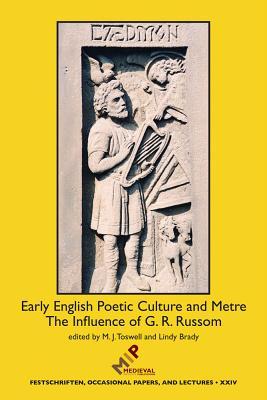Read Early English Poetic Culture and Meter: The Influence of G. R. Russom - Lindy Brady file in PDF
Related searches:
Early English Poetic Culture and Meter: The Influence of G. R
Early English Poetic Culture and Meter: The Influence of G. R. Russom
Project MUSE - Early English Poetic Culture and Meter
The Rise and Fall of Meter: Poetry and English National
Rhythm and Meter in English Poetry
Amazon.com: The Rise and Fall of Meter: Poetry and English
(PDF) MEREDITH MARTIN. The Rise and Fall of Meter: Poetry and
M. Martin, The Rise and Fall of Meter : Poetry and English
Rise and Fall of Meter: Poetry and English National Culture
Literary Terms and Definitions L - Cn - Carson-Newman University
Anglo-Saxon Metre and Literary Studies TORCH The Oxford
Poetry: Definition and Examples LiteraryTerms.net
Meredith Martin, The Rise and Fall of Meter: Poetry and
Meter - Definition and Examples LitCharts
Poetry 101: Learn About Poetry, Different Types of Poems, and
Elegy - Definition and Examples LitCharts
This one-day workshop will feature twenty-minute papers on the study of old english and/or latin metre in anglo-saxon texts,.
Bredehoft's early english metre is a reassessment of the metrical rules for english poetry from beowulf to layamon.
In terms of the structure of a poem, old english poetry has a distinct sort of line and meter.
Nov 8, 2020 the meter of epics varies depending on cultural custom. Old germanic epics ( including those in old english) typically contained non-rhyming.
Poetry is a type of literature based on the interplay of words and rhythm. It often employs rhyme and meter (a set of rules governing the number and arrangement of syllables in each line). In poetry, words are strung together to form sounds, images, and ideas that might be too complex or abstract to describe directly.
Meter alliterative meter is a literary form with roots in the old english period, before the norman conquest of england (1066).
Russom's contributions to early english metre and style, including his fundamental reworkings and rethinkings of accepted and oft-repeated mantras, including his word-foot theory, concern for the late medieval context for alliterative metre, and the linguistics of punctuation and translation as applied to old english texts.
Metre, also spelled meter, in poetry, the rhythmic pattern of a poetic line. Various principles, based on the natural rhythms of language, have been devised to organize poetic lines into rhythmic units. These have produced distinct kinds of versification, among which the most common are quantitative, syllabic, accentual, and accentual-syllabic.
In english literature, elegy is not defined by its use of elegiac meter as described above. Until the 16th century, the definition of elegy in english literature remained somewhat indeterminate, and often was taken simply to mean a poem of serious reflection.
The early modern period of english literature began in roughly 1485, around the time and cultural celebration, with some of england's finest playwrights and poets they were the first poets to introduce new forms of poetic mete.
Meter in accentual verse: accentual verse is poetry in which the meter derives from the stress, or emphasis, placed on certain syllables. Metered verse in english is almost always accentual verse, because english is a language whose rhythm derives from stress, rather than from other factors like syllable length.
The patterns which distinguish hebrew poetry are found at several levels: sound, meter, word, and imagery. The two ways in which sound is brought into play are the repetition of consonants (related to alliteration in english poetry) and the repetition of vowel sounds (related to rhyme or assonance).
Poetry was once written according to fairly strict rules of meter and rhyme, and each fantasy and science fiction authors often create poetry for their invented cultures.
The first part refers to the type of poetic foot being used predominantly in the line. A poetic foot is a basic repeated sequence of meter composed of two or more there are other types of poetic feet commonly found in english language.
Definitionoriginsexamplesalliterative metrelater use of alliteration created for an oral culture, the earliest english poetry was alliterative, with a distinct metre.
Not an old-fashioned approach to poetry, but a dynamic, contested, and inherently nontraditional field, “english meter” concerned issues of personal and national identity, class, education, patriotism, militarism, and the development of english literature as a discipline.
As a cultural critic and poetic innovator, moreover, emerson has had an immense influence through his essays and poetry in suggesting an appropriate style and method for subsequent american poets.
Examples can be found in biblical scripture (“but many that are first / shall be last� / and it is rarely used as a metrical scheme in english poetry, though algernon charles swinburne imitated this classical meter in “choriambics.
Rhyme is perhaps the most common of these elements: countless poetic works, from limericks to epic poems to pop lyrics, contain rhymes. But equally important is meter, which imposes specific length and emphasis on a given line of poetry.
Some forms of poetry are specific to particular cultures and genres, responding to prosody is the study of the meter, rhythm, and intonation of a poem. Old english poetry used a metrical pattern involving varied numbers of syllabl.
The 20th century english poetry emerged in the early years of the 20 th century through various schools, styles, and influences: 1st phase the first phase of the movement, the school of imagism, the style of french symbolist poetry influence of dome and the dominance of war poetry, these were all different manifestations of modernism in english.

Post Your Comments: